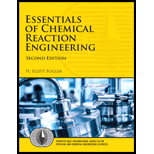
Concept explainers
(a)
Interpretation:
The list of the important items of the given chapter is to be mentioned.
Concept Introduction:
The steady state reactors are the ones in which the composition and concentration of the reactants does not change with the time. Typical examples of the steady state reactors are Continuous Stirred tank reactor (CSTR) and Plug flow reactors (PFR).
The unsteady state reactors are the ones in which the composition and concentration of the reactants change with the time. Typical examples of the unsteady state reactors are Batch reactors.
The time required to process one reactor volume is space time of the reactor.
(a)
Answer to Problem 2.2Q
CSTR, PFR, Batch Reactor equations, Arrangement of the reactors, Space time of the reactors.
Explanation of Solution
In the given chapter, there is an introduction and discussion on the different types of the reactors used in the chemical industries and the design equation that follows each one of them.
The different types of reactors studied in the chapter are,
1. CSTR
It is a steady state continuous reactor in which the entry and exit composition in the reactor is same. It is also known as Mixed Flow Reactor (MFR) as its main purpose is to mix the reactants present. It allows the back-mixing of the reactants too. The design equation that it follows is,
In the above formula,
V = Volume of the reactor
FA0 = Initial Flow rate of any reactant A
XA = Conversion achieved by the reactant A
-rA = Rate of reaction of reactant A
2. PFR
It is a steady state reactor which does not allow mixing of the components. Only lateral mixing is allowed, no axial mixing. The reactants flow in a stream-line path in the reactor with no overtaking. It is also known as the tubular reactor.
The design equation that it follows is,
In the above formula,
V = Volume of the reactor
FA0 = Initial Flow rate of any reactant A
XA = Conversion achieved by the reactant A
-rA = Rate of reaction of reactant A
3. Batch Reactor
It is the unsteady state reactor in which the conversion achieved is a function of time.
The design equation it follows is,
In the above formula,
t = Time required to achieve desired conversion
V = Volume of the reactor
NA0 = Number of moles of any reactant A
XA = Conversion achieved by the reactant A
-rA = Rate of reaction of reactant A
4. PBR
It is the Packed Bed Reactor similar to the PFR but it is used in solid reactions and not the fluid ones. They are filled with the catalyst particles.
The design equation that it follows is,
In the above formula,
W = Weight of the catalyst
FA0 = Initial Flow rate of any reactant A
XA = Conversion achieved by the reactant A
-rA = Rate of reaction of reactant A
(B) The arrangement of different types of flow reactors to achieve maximum conversion is mentioned. A PFR will give more conversion than a CSTR for a given volume of the reactor.
(C) To obtain maximum conversion, the CSTR in series will give more conversion than a single CSTR of equivalent volume.
(D) The graphical representation of CSTR and PFR for a given conversion is obtained with respect to the reaction rate.
(E) The space time is the ratio of the Volume of reactor to the volumetric flow rate and is given as,
v0 = Volumetric flow rate of the fluid
V = Volume of reactor
(F) Space velocity is the reciprocal of space time and it is given as,
SV = Space velocity
(b)
Interpretation:
The overall purpose of the chapter is to be mentioned.
Concept Introduction:
The steady state reactors are the ones in which the composition and concentration of the reactants does not change with the time. Typical examples of the steady state reactors are Continuous Stirred tank reactor (CSTR) and Plug flow reactors (PFR).
The unsteady state reactors are the ones in which the composition and concentration of the reactants changes with the time. Typical examples of the unsteady state reactors are Batch reactors.
The time required to process one reactor volume is space time of the reactor.
(b)
Answer to Problem 2.2Q
Introduction to the concept of reactors and differentiate between the reactors.
Explanation of Solution
The given chapter introduces the different types of reactor used in the chemical industry. The reactor forms the basis of the Chemical
The main purpose of the chapter is to make the reader aware of the different types of flow reactors and non-flow reactors and to make sure where each one of them can be applied for the given kinetics of the reaction.
This chapter enables the readers to easily identify and differentiate between different types of the reactors and how to identify the conversions from a reactor by using the design equation of the reactors as well as the graphical method of representation.
Want to see more full solutions like this?
Chapter 2 Solutions
Essentials of Chemical Reaction Engineering (2nd Edition) (Prentice Hall International Series in the Physical and Chemical Engineering Sciences)
 Introduction to Chemical Engineering Thermodynami...Chemical EngineeringISBN:9781259696527Author:J.M. Smith Termodinamica en ingenieria quimica, Hendrick C Van Ness, Michael Abbott, Mark SwihartPublisher:McGraw-Hill Education
Introduction to Chemical Engineering Thermodynami...Chemical EngineeringISBN:9781259696527Author:J.M. Smith Termodinamica en ingenieria quimica, Hendrick C Van Ness, Michael Abbott, Mark SwihartPublisher:McGraw-Hill Education Elementary Principles of Chemical Processes, Bind...Chemical EngineeringISBN:9781118431221Author:Richard M. Felder, Ronald W. Rousseau, Lisa G. BullardPublisher:WILEY
Elementary Principles of Chemical Processes, Bind...Chemical EngineeringISBN:9781118431221Author:Richard M. Felder, Ronald W. Rousseau, Lisa G. BullardPublisher:WILEY Elements of Chemical Reaction Engineering (5th Ed...Chemical EngineeringISBN:9780133887518Author:H. Scott FoglerPublisher:Prentice Hall
Elements of Chemical Reaction Engineering (5th Ed...Chemical EngineeringISBN:9780133887518Author:H. Scott FoglerPublisher:Prentice Hall
 Industrial Plastics: Theory and ApplicationsChemical EngineeringISBN:9781285061238Author:Lokensgard, ErikPublisher:Delmar Cengage Learning
Industrial Plastics: Theory and ApplicationsChemical EngineeringISBN:9781285061238Author:Lokensgard, ErikPublisher:Delmar Cengage Learning Unit Operations of Chemical EngineeringChemical EngineeringISBN:9780072848236Author:Warren McCabe, Julian C. Smith, Peter HarriottPublisher:McGraw-Hill Companies, The
Unit Operations of Chemical EngineeringChemical EngineeringISBN:9780072848236Author:Warren McCabe, Julian C. Smith, Peter HarriottPublisher:McGraw-Hill Companies, The





